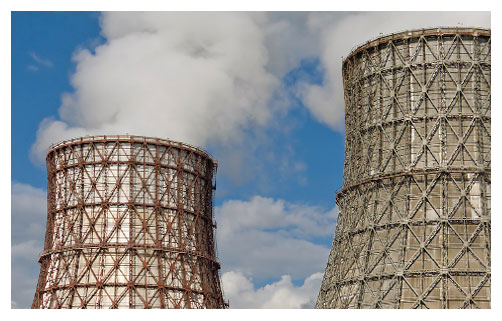



Nuclear energy can be created through two processes: fission (splitting the nucleus, or the core, of an atom to release energy) and fusion (combining the nuclei of two atoms to release energy). At this time, all nuclear reactors (power plants) make electricity through fission. Scientists have been working for decades to harness the power of fusion, which releases much more energy than fission, but because of the immense amount of energy needed to trigger the reaction, no models for the peaceful use of fusion technology exist on Earth today. (However, fusion is employed in thermonuclear, or hydrogen, bombs.) The sun is one example of a fusion reactor.
The way that a nuclear reactor works is as follows and is not all that different from other types of generators. These reactors heat water to produce steam, which in turn turns turbines to turn the generators that produce electricity. The difference lies in the fact that nuclear reactors use nuclear fission to release the energy inside of atoms. Here is the chain reaction that releases the energy needed to make heat: Neutrons smash into the nucleus of the atoms contained in the reactors' "fuel," which are rods of Uranium, and these split atoms release energy in the form of heat. From here on in, the reactors work in a similar fashion to other steam-based energy sources, such as those that burn fossil fuels.
Coal-, gas-, and nuclear-powered power plants all use steam pressure to turn turbine blades, and then the mechanical energy of the turning blades is converted into electrical energy for consumption. Nuclear plants employ fission to produce steam: Uranium atoms are bombarded by neutrons, which split the atoms' nuclei into smaller nuclei, releasing energy in the form of heat and freeing more neutrons, which in turn collide with and split more uranium nuclei, creating a chain reaction. The heat released by the reaction boils water in the reactor's core and creates steam to power the turbine.
Because one ton of uranium can generate more than 40 million kilowatt-hours of electricity--equal to 16,000 tons of coal or 80,000 barrels of oil--nuclear energy is often considered more resource-efficient than traditional forms of fuel. We will probably continue to have uranium reserves after we have exhausted available coal and oil resources. In addition, because nuclear reactors do not produce greenhouse gases, they don't contribute to global warming and climate change.
But nuclear energy also presents us with many problems and dangers. The radioactivity that makes uranium a suitable fuel can damage living organisms' cellular structure. While we are surrounded by low levels of radiation all the time, emitted by everything from the appliances we use every day to the cosmos itself, very high levels of radiation can cause death immediately, and lower levels can cause burns, cellular mutation, and cancer. The process of generating nuclear energy releases environmentally hazardous radiation at every stage, from mining and enriching uranium ore to the radioactive by-products and waste that need to be disposed of.
A typical reactor produces about 20-30 tons of high-level radioactive waste each year, and many more tons of low-level waste. Depleted uranium is used for commercial and military purposes; while it is only weakly radioactive, it can be extremely toxic if inhaled. Plutonium, another nuclear by-product, is vulnerable to theft and use for weapons. At this time, power plants are storing their waste in temporary cooling pools and containers until a long-term solution is determined. Yucca Mountain, Nevada, was selected to be the permanent holding site for the nation's high-level nuclear waste, but critics note that the already accumulated waste alone will come close to filling the facility, and that transporting waste from across the country could lead to dangerous accidents. There is also the potential for radiation leakage from the site. In part because of these issues, development of Yucca Mountain has been repeatedly delayed.
Another great challenge to achieving safe nuclear technologies is the possibility that, in an operating power plant, the uranium fuel rods could become so hot that they shatter or melt through the reactor's core, causing widespread contamination throughout the environment. In 1979, the worst nuclear incident in US history occurred at Pennsylvania's Three Mile Island power plant and caused a full-scale evacuation of the surrounding communities. In 1986, one reactor in the Chernobyl power plant in present-day Ukraine exploded. Thirty people died instantly, and thousands of deaths have been attributed to the radioactive dust that blanketed the area and spread as far as the Eastern United States.
In the next several years, many of the nuclear power plants currently operating in the US will reach the end of their lifespans. We face a dilemma: What will we do when these reactors are taken offline? Utilities and the federal government are creating plans to build a series of "Generation IV" nuclear power plants, pointing to the need to meet consumers' ever-increasing demands for electricity. Renewable energies, such as solar, wind, and tide, can supply some of the demand, but not all. Coal and oil produce greenhouse gases. Perhaps the better answer lies in examining our demand for energy and asking if we are willing to risk our health and that of our environment, or whether we can instead make the choice to live in ways that demand less electricity.
For more information on nuclear energy go to:
ThinkQuest,
"The Nuclear Fission Power Plant":
www.library.thinkquest.org
Union of Concerned Scientists,
"How Nuclear Power Works":
www.ucsusa.org
US Environmental Protection Agency,
""Nuclear Energy":
www.epa.gov
Yucca Mountain:
www.yuccamountain.org
![]()

Back to Top